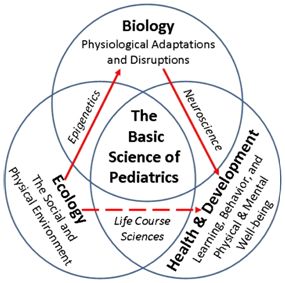(Dr. Robert Lee, DO, MS, FAAP is a pediatrician and Associate Pediatric Residency Program Director at NYU Winthrop Hospital. He is NYS AAP Chapter 2 Secretary and Co-Chair of the Foster/Kinship Care Committee. He is a member of the Middle Childhood Expert Panel for the Bright Futures Guidelines, 4th Edition.)
What is Bright Futures?
Bright Futures is a set of principles, strategies, and tools that are theory based, evidence driven, and systems oriented that can be used to improve the health and well-being of all children through culturally appropriate interventions that address their current and emerging health promotion needs at the family, clinical practice, community, health system, and policy levels.
Bright Futures is a national health promotion and prevention initiative, led by the AAP and supported by the U.S. Department of Health and Human Services, Health Resources and Services Administration (HRSA), Maternal and Child Health Bureau. The book, Bright Futures Guidelines, 4th Edition, is the core of the Bright Futures tools for practice and provides theory-based and evidence-driven guidance for all preventive care screenings and health supervsion visits. The Bright Futures Tool and Resource Kit that accompanies the book is designed to assist pediatricians in planning and carrying out health supervision visits. It contains numerous charts, forms, screening instruments, and other tools that increase practice efficiency and efficacy. According to Joseph Hagan, MD, FAAP (Bright Futures Co-Editor), “The Periodicity Schedule tells us what should be done in a well visit, I believe Bright Futures tells us how to do it well.”
What’s New in the Fourth Edition?
 The Fourth Edition builds upon previous editions with thoroughly revised and updated content that reflects the latest research. Because of the science of early brain development, adverse childhood events (ACEs) and toxic stress, environmental and social determinants of health, the AAP has adopted an eco-bio-developmental model of human health and diseases (Figure). Bright Futures incorporates this new science into the development of a new health promotion theme: Promoting Lifelong Health for Families and Communities. It provides a current review of the science of development and insight for how this science might be applied in our practices and clinics. For most visits, pediatricians are encouraged to ask about topics such as food insecurity, domestic violence, substance use, housing situations and other issues that may affect a family’s health. In addition, there are major updates to several adolescent screenings including: cervical dysplasia; depression; dyslipidemia; hearing; vision; tobacco, alcohol, and drug use.
The Fourth Edition builds upon previous editions with thoroughly revised and updated content that reflects the latest research. Because of the science of early brain development, adverse childhood events (ACEs) and toxic stress, environmental and social determinants of health, the AAP has adopted an eco-bio-developmental model of human health and diseases (Figure). Bright Futures incorporates this new science into the development of a new health promotion theme: Promoting Lifelong Health for Families and Communities. It provides a current review of the science of development and insight for how this science might be applied in our practices and clinics. For most visits, pediatricians are encouraged to ask about topics such as food insecurity, domestic violence, substance use, housing situations and other issues that may affect a family’s health. In addition, there are major updates to several adolescent screenings including: cervical dysplasia; depression; dyslipidemia; hearing; vision; tobacco, alcohol, and drug use.
How is New York State using Bright Futures?
The New York State Department of Health (DOH) is leading the implementation of Bright Futures. DOH has worked with many state partners to ensure that Bright Futures Guideline is the primary resource for preventive services and health care supervision. DOH began by working with NYS Medicaid office to infuse Bright Futures into the Medicaid provider handbook. Specifically, the handbook includes the Periodicity Schedule, which DOH updates to match any changes made by the AAP. Next, DOH shared the Bright Futures Guidelines with other state agencies, demonstrating their relevance to the agencies’ work and generally increasing awareness of Bright Futures. DOH also shared the Bright Futures Guidelines with the Office of Mental Health for use with children and youth with emotional health issues. The use of Bright Futures across these agencies allows state programs to communicate using a common language.
The NYS AAP Chapter 2 and 3 Pediatric Council have worked with individual insurance providers to explain the importance of Bright Futures recommended services, such as developmental screening, in sustaining child health and to ensure providers receive insurance payments for services recommended by Bright Futures.
How can Pediatricians implement Bright Futures into their Practices?
Many pediatricians have asked whether it is really possible to implement the recommendations in Bright Futures Guidelines in daily clinical practice. The answer is Yes! Carrying out Bright Futures means making full use of all the Bright Futures materials. For pediatricians who wish to improve their skills, Bright Futures has developed a range of resources and materials that complement the Bright Future Guidelines. The Bright Futures Tool and Resource Kit allows pediatricians who wish to improve their practice or services to efficiently and comprehensively carry out new practices and practice change strategies. The Bright Futures tools also are compatible with suggested templates for the electronic health record (EHR).
- Bright Futures Previsit Questionnaire, which a parent or patient completes before the pediatrician begins the visit. When the questionnaire is completed, the family’s agenda, and many of the child’s strengths, screening requirements, and intervention needs, is highlighted.
- Screening tools, such as standardized developmental assessment tests and screening questionnaires that allow pediatricians to screen children and youth for certain conditions at specific visits.
- Bright Futures Visit Chart Documentation Form, which corresponds to the Bright Futures Guidelines tasks for that visit and the information that is gleaned from the parent questionnaire. It reduces repetitive charting and frees the pediatrician for more face-to-face time with the child or youth.
- Bright Futures Preventive Services Prompting Sheet, which affords an at-a-glance compilation of work that is done over multiple visits to ensure completeness and increase efficiency.
- Parent/Child Anticipatory Guidance Materials, which reinforce and supplement the information discussed at the visit.
For more information about how to implement Bright Futures recommendations click here.


